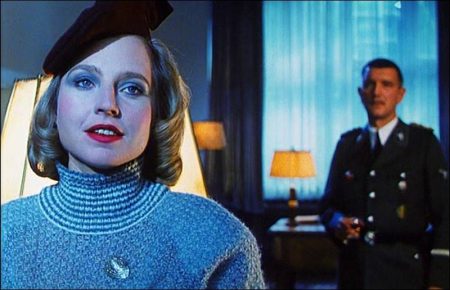Lili Marleen movie storyline. In Switzerland, German singer Willie falls in love with Jewish composer, Robert, who offers resistance to the Nazis by helping refugees. But his family thinks Willie is a Nazi and may be a risk for them. One day Willie helps Robert but, has to stay in Germany. As Willie starts to sing the song ‘Lili Marleen’ she becomes very famous and every soldier hears that song via radio – even Hitler wants to meet her, but she still does not forget Robert, and helps to smuggle photos of concentration camps to the free Switzerland. Robert wants to visit her, but is captured. Will never see Willie again until war is over.
Lili Marleen is a 1981 West German drama film directed by Rainer Werner Fassbinder and starring Hanna Schygulla. The screenplay was produced using the autobiographical novel Der Himmel hat viele Farben (The Heavens Have Many Colors) by Lale Andersen. However, according to Lale Andersen’s last husband, Arthur Beul, the film’s plot bore little relation to her real life.

Film Review for Lili Marleen
Many critics have felt offended that R.W. Fassbinder has portrayed both protagonist Wilkie and the Nazis in this movie in a human-like manner. Connoisseurs of other Fassbinder films, however, will realize that “Lili Marleen” (1981) belongs to Fassbinder’s “women movies” like “The Marriage of Maria Braun” (1979) and “Lola” (1981). Fassbinder was convinced that “stories can be told much better with women than with men”, because, according to Fassbinder, while men usually fulfill their determined roles in society, “women are capable of thinking in a dialectic manner”.
Dialectics, however, means that there is not only a thesis and its antithesis like usually in our black-and-white world, but a synthesis where the oppositions coincide. Moreover, dialectic means that because of the third instance of synthesis the absolute opposition of the difference between thesis and antithesis is abolished. Concretely speaking:
Starting from a dialect point of view and portraying the fascist state, the underground fighters must necessarily use the basic means like the rulers do, and between offenders and victims there is thus a chiastic relation, so that every offender is also victim and every victim is also offender. Fassbinder has illustrated this abstract scheme, that transcends classical logic, in his play “The City, the Garbage and the Death” (1975) which was filmed by Daniel Schmid under the title “Shadow of Angels” (1976).
Therefore, approaching an a priori controversial topic like Nazi Germany, in a dialectic manner, the depiction of this time in the form of a movie gets even more controversial, especially for people who cannot or do not want to see that our recognition of the world is by far not exhausted with a primitive light-switch schema, but needs the third instance of synthesis as controlling instance of its opposite members thesis and antithesis.
The mutual relationship between offenders and victims has to scrutinized, since it is simply not true that the offenders are the bad ones and the victims the good ones. In a synthetic viewpoint, the bad ones participate on the goodness as the good ones participate on the badness. They are mutually related. In a world-view based on classical logic, a relation between good and bad cannot even been established, and in an ethics based on this insufficient system of logic, the bad conscience of the survivors of Nazi Germany, feeling (illogically enough) responsible for the deeds of their ancestors, exclude the possibility of a relationship between the two extremes and thus a synthesis in the form a new evaluation based on this relationship as well.
From Fassbinder’s dialectic viewpoint, it follows that neither Lili Marleen nor Lola nor Maria Braun can be condemned for their “misuse” of the ruling system for their private purposes, because they don’t misuse them, they just use them. In the opposite, since victims must repeat the actions of the offenders as the offenders must repeat the actions of the victims, because “good” and “bad” are no longer simple mirror images of one another like in two-valued logic, their strategies are legitimated by the chiastic structure of a logic that describes our world, that is not black and white at all, much better than a black-and-white logic.
Lili Marleen (1981)
Directed by: Rainer Werner Fassbinder
Starring: Hanna Schygulla, Giancarlo Giannini, Mel Ferrer, Karl-Heinz von Hassel, Erik Schumann, Hark Bohm, Gottfried John, Karin Baal, Christine Kaufmann, Udo Kier, Adrian Hoven
Screenplay by: Lale Andersen, Rainer Werner Fassbinder, Manfred Purzer, Joshua Sinclair
Production Design by: Rolf Zehetbauer
Cinematography by: Xaver Schwarzenberger, Michael Ballhaus
Film Editing by: Rainer Werner Fassbinder, Juliane Lorenz
Costume Design by: Barbara Baum
Art Direction by: Herbert Strabel
Music by: Peer Raben
MPAA Rating: None.
Distributed by: United Artists Classics
Release Date: January 14, 1981
Views: 204


